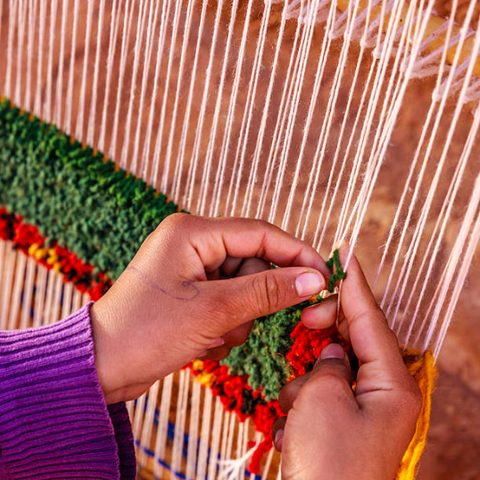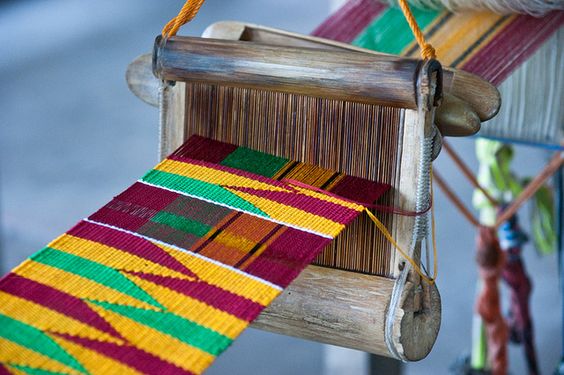Africa, my beloved continent immensely rich in diversity and culture, is a kaleidoscope of vibrant colours that narrate the stories of traditions, histories, and identities of its many peoples. In this blog post of African design, we delve into the foundational colours of the continent, uncovering their origins, cultural significance, and the stories they tell. Although there are countless cultures to consider, for this article, we will focus on the symbolic hues found in the Yoruba (Nigeria), Ashanti (Ghana), Berber (North Africa), Zulu (South Africa), Uganda, and the Democratic Republic of Congo (DRC), revealing the unique narratives woven into their vibrant tones.
Yoruba - Nigeria: Indigo (Adire): Indigo holds a special place in Yoruba culture. Adire, a traditional Yoruba indigo-dyed cloth, features intricate patterns. The deep blue symbolises spirituality and is worn during significant ceremonies and rites of passage.
 White (Funfun): White represents purity and spirituality in Yoruba traditions. It is commonly donned during religious ceremonies, associated with transcending the physical realm.
White (Funfun): White represents purity and spirituality in Yoruba traditions. It is commonly donned during religious ceremonies, associated with transcending the physical realm.
Red (Pupa): Red signifies vitality, courage, and life force. It is a prominent feature in Yoruba beadwork, textiles, and regalia, especially during festivals and celebrations.

Ashanti - Ghana: Gold (Sunsum): The Ashanti people are known for their association with gold, a symbol of wealth, royalty, and spiritual purity. Golden ornaments and fabrics are adorned by royalty and during significant cultural events.

Black (Mmere Dane): Black represents maturity, wisdom, and life's cyclical nature. It is often used at funerals and commemorations, symbolising the transition from life to the afterlife.
Green (Ahosu): Green symbolises growth, vitality, and the land's bountiful resources. It is a color of abundance in Ashanti textiles and garments.

Berber - North Africa: Blue (Azrarn): The Berber people, particularly in Morocco, use blue in their architecture and textiles, signifying spirituality and protection, believed to ward off evil. The famous blue city of Chefchaouen reflects this cultural significance.

Yellow (Azeggwagh): Yellow symbolises prosperity, fertility, and the sun's warmth. It is present in Berber jewellery, carpets, and traditional attire, reflecting their connection to nature and the desert.
Green (Akermoud): Green represents the oasis, life's fertility, and flourishing. It is a color of hope in Berber tapestries and rugs, celebrating the natural world's vibrancy.

Uganda: Red and Black (Bark Cloth): Red and black tones in bark cloth are traditions primarily associated with the Baganda people of Uganda. Bark cloth, or "omutembeeyi" in Luganda, holds significant cultural and spiritual value and is used in various ceremonies and traditional wear.
Earth Tones (Kikoy): Earthy colors like brown and green are prevalent in traditional Ugandan kikoys. These colors symbolise the country's agricultural wealth and natural beauty.

Democratic Republic of Congo (DRC): Mud Cloth (Lutindzi): Mud cloth, or lutindzi, is associated with the Mangbetu and Zande peoples in the DRC's northeast. These earthy tones symbolise a connection to the earth and the traditions of these communities.

Royal Blue and Yellow (Kuba Cloth): The Kuba people, or Bakuba, from the Kasai region, create Kuba cloth characterized by royal blue and yellow geometric patterns, representing royalty, prestige, and cultural richness.

Zulu - South Africa: Black and White (Isigqila): Zulu beadwork often uses black and white beads, symbolizing life's duality and emphasising balance and harmony.

Red (Umhlophe): Red in Zulu beadwork signifies passion, love, and vitality. It is commonly used in accessories and garments for celebrations and ceremonies.
Yellow (Luhlaza): Yellow, symbolising the sun, conveys warmth, energy, and positivity. Yellow beads in Zulu beadwork are worn during joyful occasions.

The vibrant colours prevalent in the African continent are more than a visual feast; they are a language expressing the richness of diverse cultures and histories. Each hue tells a story of tradition, spirituality, and the deep connection between people and their environment. As we unravel the meanings behind these colours, we gain a deeper appreciation for the tapestry that is Africa, a continent painted with the hues of heritage and ancient culture, essential to African design and interiors.
Are you an interior designer? Embark on a colourful journey with our African Textile Guide, perfect for interior designers and textile enthusiasts seeking to infuse their projects with the rich tapestry of African culture. This guide offers a window into the soul of the African continent, showcasing textiles that narrate stories of tradition, spirituality, and the deep bond between people and nature.
Elevate your creative projects by incorporating these captivating fabrics, not just for their aesthetic beauty but for their profound cultural significance. This guide is more than just a resource; it's an inspiration to create spaces that resonate with the heart of African heritage. Download our guide now and transform your designs with the timeless appeal and vibrant spirit of African textiles!


Leave a comment